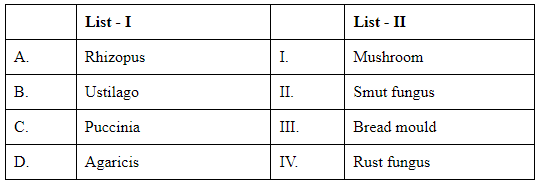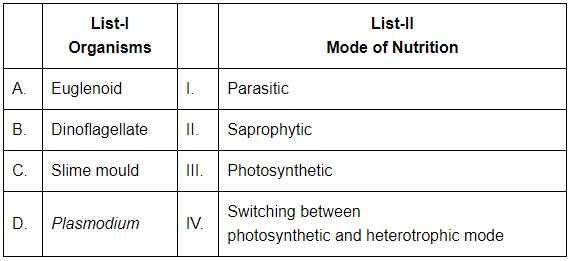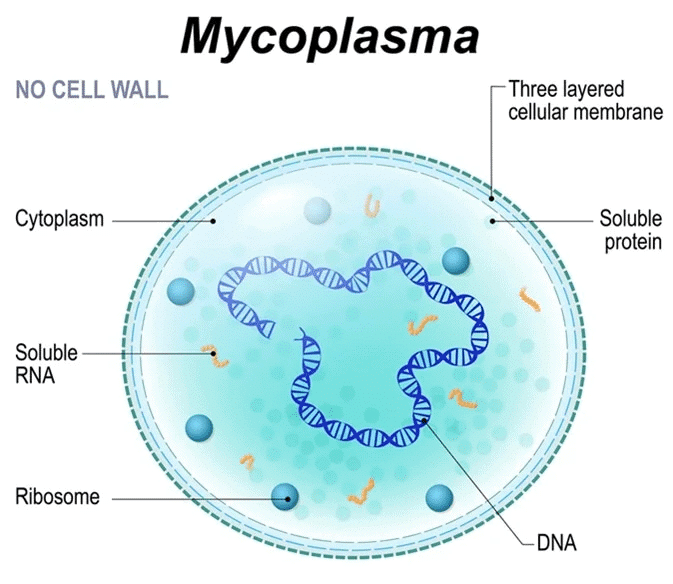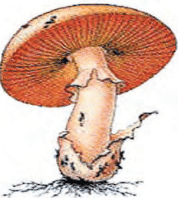From 2016 to 2025, 26 questions were asked on classification and nomenclature. Mostly one or two questions appeared in the exam (scattered across 2019, 2020, 2021, 2022, and 2025), with none from 2023. The questions were primarily focused on Whittaker's five kingdoms, fungal and protist classification, viroids/prions, and prokaryotic/eukaryotic distinctions, with no specific difficulty distribution provided in the data. Key focus areas included body organization complexity, criteria for fungal taxonomy (e.g., mycelium, spores, fruiting bodies), spore types (conidia, basidiospores), and characteristics of groups like Deuteromycetes, Archaebacteria, and Mycoplasma.

2025
Q1: Each of the following characteristics represent a Kingdom proposed by Whittaker. Arrange the following in increasing order of complexity of body organization.
A. Multicellular heterotrophs with cell wall made of chitin.
B. Heterotrophs with tissue/organ/organ system level of body organization.
C. Prokaryotes with cell wall made of polysaccharides and amino acids.
D. Eukaryotic autotrophs with tissue/organ level of body organization.
E. Eukaryotes with cellular body organization.
Choose the correct answer from the options given below:
(a) A, C, E, D, B
(b) C, E, A, B, D
(c) A, C, E, B, D
(d) C, E, A, D, B
Ans: (d)
Whittaker proposed five kingdoms based on cellular structure and body organization. The correct increasing order of complexity is:
- C: Kingdom Monera (Prokaryotes; simplest)
- E: Kingdom Protista (Unicellular eukaryotes)
- A: Kingdom Fungi (Multicellular without true tissues)
- D: Kingdom Plantae (Tissues and organs)
- B: Kingdom Animalia (Tissues, organs, and organ systems)
Thus, the increasing order of complexity is: C, E, A, D, B.
2024
Q1: Which one of the following is not a criterion for classification of fungi? (NEET 2024)
(a) Morphology of mycelium
(b) Mode of nutrition
(c) Mode of spore formation
(d) Fruiting bodyAns: (b)
The classification of fungi is based on various criteria that broadly include morphology, genetics, and physiological features. Each of the provided options, except one, is a valid criterion for the classification of fungi:
- Morphology of mycelium: Fungi can have different types of mycelium, which refers to their vegetative structure. Fungi can be classified based on whether they have septate (with cross-walls) or coenocytic (without cross-walls) mycelium. This morphological characteristic is crucial for classification.
- Mode of spore formation: Spore formation in fungi is a key reproductive strategy and varies significantly among different groups. Spores can be produced sexually or asexually, and the structures involved in spore production are critical for classification. Fungi are often categorized based on whether they form spores inside a sac (ascospores) or on basidia (basidiospores), among others.
- Fruiting body: The presence and type of fruiting body (such as mushrooms, toadstools, puffballs, etc.) are used in fungi classification. These structures are involved in the production of spores and can be quite distinctive among different fungi groups.
However, the option that is not a criterion for the classification of fungi is:
Mode of nutrition: While fungi are heterotrophic (meaning they obtain their food by absorbing dissolved molecules, typically from decomposing material), this characteristic is generally true across all fungi. They can be saprophytic (decomposers), parasitic (feeding on living organisms), or mutualistic (engaging in mutually beneficial relationships). Despite these differences in their ecological roles or interactions, the mode of nutrition is not typically used as a primary criterion for formal taxonomic classification in fungi. It is more pertinent to ecological or functional groupings rather than taxonomic classification.
Therefore, the correct answer is Option B: Mode of nutrition.
Q2: Match List I with List II (NEET 2024)

Choose the correct answer from the options given below:
(a) A-III, B-II, C-IV, D-I
(b) A-I, B-III, C-II, D-IV
(c) A-III, B-II, C-I, D-IV
(d) A-IV, B-III, C-II, D-I
Ans: (a)
Let's analyze the matching based on what each item in List I corresponds to in List II:
- Rhizopus is commonly known as black bread mold, which matches with "Bread mould." Therefore, Rhizopus corresponds to III.
- Ustilago is a type of smut fungus that affects grains, so it rightfully matches with "Smut fungus." Thus, Ustilago corresponds to II.
- Puccinia is well-known for causing rust in plants, indicating that it matches with "Rust fungus." This means Puccinia corresponds to IV.
- Agaricus is the genus that includes various mushrooms, such as the common button mushroom. This matches with "Mushroom," so Agaricus corresponds to I.
Given the matches:
A - Rhizopus corresponds to III, B - Ustilago corresponds to II, C - Puccinia corresponds to IV, D - Agaricus corresponds to I. Comparing these with the provided options:
Option A (A-III, B-II, C-IV, D-I) matches exactly with the analysis above.
Therefore, the correct answer is: Option A.
Q3: The asexual spores of deuteromycetes are: (NEET 2024)
(a) Aplanospores
(b) Conidia
(c) Zoospores
(d) Basidiospores
Ans: (b)
Deuteromycetes, also known as imperfect fungi, reproduce asexually through spores called conidia. These spores are produced exogenously on specialized structures called conidiophores. Other options such as aplanospores and zoospores are associated with different fungal groups, while basidiospores are produced by basidiomycetes.
Q4: Match List-I with List-II: (NEET 2024)

Choose the correct answer from the options given below:
(a) A-III, B-IV, C- II, D- I
(b) A-IV, B-II, C- I, D- III
(c) A-IV, B-III, C- II, D- I
(d) A-IV, B-II, C- III, D- I
Ans: (c)
A. Euglenoid: Euglenoids can switch between photosynthetic and heterotrophic modes, thus matching with IV.
B. Dinoflagellate: Many dinoflagellates are photosynthetic, aligning with III.
C. Slime mould: Slime moulds are primarily saprophytic, which corresponds to II.
D. Plasmodium: Plasmodium is a well-known parasitic organism, matching with I.

2022
Q1: Given below are two statements: (NEET 2022 Phase 1)
Statement I: Mycoplasma can pass through less than 1 micron filter size.
Statement II: Mycoplasma are bacteria with cell wall.
In the light of the above statements, choose the most appropriate answer from the options given below:
(a) Statement I is correct but Statement II is incorrect
(b) Statement I is incorrect but Statement II is correct
(c) Both Statement I and Statement II are correct
(d) Both Statement I and Statement II are incorrect
Ans: (a)
Mycoplasma are the smallest cells and are only 0.3 μm in length. So it can pass through less than 1 μm filter size.
Mycoplasma lack cell wall.

Question for NEET Previous Year Questions (2016-2025): Biological Classification
Try yourself:Q2: Which of the following is a correct statement? (NEET 2022 Phase 1)
(a) (b) (c)(d)
Explanation
Ans: (A)
- Slime moulds are classified under kingdom Protista.
- Mycoplasma lack cell wall.
- Bacteria can be autotrophic as well as heterotrophic.
Report a problem
Q3: Mad cow disease in cattle and Cr Jacob disease in humans are due to infection by ______.
(a) Prion
(b) Bacterium
(c) Virus
(d) Viroid (NEET 2022 Phase 2)
Ans: (a)
Prions are abnormally folded proteins. They cause mad cow disease in cattle and Cr Jacob disease in humans.
2021
Q1: Which of the following statements is correct? (NEET 2021)
(a) Organisms that depend on living plants are called saprophytes.
(b) Some of the organisms can fix atmospheric nitrogen in specialised cells called sheath cells.
(c) The fusion of two cells is called Karyogamy.
(d) Fusion of protoplasms between two motile on non-motile gametes is called plasmogamy.
Ans: (d)
- In some blue-green algae specialised cells called heterocyst fixes atmospheric nitrogen into ammonia.
- Fusion of two nuclei is called Karyogamy.
- Organisms that depend on living plants are parasites, saprophytes grow on dead material.
- Fusion of protoplasts of two cells is called plasmogamy.
2020
Q1: Which of the following is correct about viroids? (NEET 2020)
(a) They have DNA with protein coat.
(b) They have free DNA without protein coat.
(c) They have RNA with protein coat.
(d) They have free RNA without protein coat.
Ans: (d)
Viroids have free RNA without protein coat. Viroid, an infectious particle smaller than any of the known viruses, an agent of certain plant diseases. The particle consists only of an extremely small circular RNA (ribonucleic acid) molecule, lacking the protein coat of a virus.
2019
Q1: Which of the following statements is incorrect? (NEET 2019)
(a) Prions consist of abnormally folded proteins.
(b) Viroids lack a protein coat.
(c) Viruses are obligate parasites.
(d) Infective constituent in viruses is the protein coat.
Ans: (d)
- Virus : Viruses are obligate parasites. In addition to proteins, viruses also contain genetic material that could be either RNA or DNA. No virus contains both RNA and DNA. A virus is a nucleoprotein and the genetic material is infectious. The infective constituent in viruses is the nucleic acid, not the protein coat.
- Viroids: It lacks the protein coat that is found in viruses and hence, the name viroid.
- Prions: In modern medicine, certain infectious neurological diseases were found to be transmitted by an agent consisted of abnormally folded protein.
Q2: Which of the following statements is incorrect? (NEET 2019)
(a) Yeasts have filamentous bodies with Iong thread-like hyphae.
(b) Morels and truffles are edible delicacies.
(c) Claviceps is a source of many alkaloid and LSD.
(d) Conidia are produced exogenously and ascospores endogenously.
Ans: (a)
Yeast is an unicellular sac fungus. It lacks filamentous structure or hyphae.
Question for NEET Previous Year Questions (2016-2025): Biological Classification
Try yourself:Q3: Select the correctly written scientific name of Mango which was first described by Carolus Linnaeus :
Explanation
Ans: (a)
According to rules of binomial nomenclature, the correct scientific name of mango is Mangifera indica Linn.
Report a problem
2018
Q1: Which among the following is not a prokaryote? (NEET 2018)
(a) Saccharomyces
(b) Mycobacterium
(c) Nostoc
(d) Oscillatoria
Ans: (a)
Q2: Select the wrong statement. (NEET 2018)
(a) Cell wall is present in members of fungi and plantae.
(b) Mushrooms belong to basidiomycetes.
(c) Pseudopodia are locomotory and feeding structures in sporozoans.
(d) Mitochondria are the powerhouse of the cell in all kingdoms except monera.
Ans: (c)
- Cell wall is present in the member of Fungi (made up of chitin) and Plantae (made up of cellulose).
- Pseudopodia are locomotory and feeding structures in Amoeboid Protozoans.
- Mitochondria and other membrane bound cell organelles are absent in prokaryote (Monera). Mushroom, rust and smut fungus belongs to the class basidiomycetes.
Q3: After karyogamy followed by meiosis, spores are produced exogenously in ______. (NEET 2018)
(a) Neurospora
(b) Alternaria
(c) Agaricus
(d) Saccharomyces
Ans: (c)
Karyogamy and meiosis takes place in the basidium producing four basidiospores. The basidiospores are exogenously produced on the basidium. The basidia are arranged in fruiting bodies called basidiocarps. Some common members are agaricus (mushroom).
 Agaricus
Agaricus
Q4: Which of the following organisms are known as chief producers in the oceans? (NEET 2018)
(a) Dinoflagellates
(b) Diatoms
(c) Cyanobacteria
(d) Euglenoids
Ans: (b)
Diatoms are the most common form of phytoplankton in the ocean. They have the pigment chlorophyll which helps in photosynthesis. Since they are the primary producers of the aquatic chain and the marine ecosystem depends on them. They are called chief producers in the oceans.
Q5: Ciliates differ from all other protozoans in: (NEET 2018)
(a) Using flagella for locomotion.
(b) Having a contractile vacuole for removing excess water.
(c) Using pseudopodia for capturing prey.
(d) Having two types of nuclei.
Ans: (d)
Ciliates differs from other protozoans in having two types of nuclei. e.g., Paramoecium have two types of nuclei i.e. macronucleus & micronucleus.
2017
Q1: Viroids differ from viruses in having: (NEET 2017)
(a) DNA molecules without protein coat
(b) RNA molecules with protein coat
(c) RNA molecules without protein coat
(d) DNA molecules with protein coat
Ans: (c)
Viroids are free RNA particles that lack protein coat. They are infectious agents smaller than viruses.
Q2: Which of the following are found in extreme saline conditions? (NEET 2017)
(a) Eubacteria
(b) Cyanobacteria
(c) Mycobacteria
(d) Archaebacteria
Ans: (d)
Halophiles, a type of archaebacteria, usually occur in extreme saline conditions like salt pans, salt beds and salt marshes
Q3: Which among the following are the smallest living cells, known without a definite cell wall, pathogenic to plants as well as animals and can survive without oxygen? (NEET 2017)
(a) Pseudomonas
(b) Mycoplasma
(c) Nostoc
(d) Bacillus
Ans: (b)
Mycoplasmas are smallest, prokaryotes lacking cell wall and are pleomorphic in nature. These are pathogenic to both plants and animals.
2016
Question for NEET Previous Year Questions (2016-2025): Biological Classification
Try yourself:Q1: Which one of the following is wrong for fungi? (NEET 2016 Phase 2)
Explanation
Ans: (c)
Cell wall in fungi is composed of chitin, a polysaccharide comprising N-acetyl-Dglucosamine (a derivative of glucose).
Report a problem
Q2: Methanogens belong to ______. (NEET 2016 Phase 2)
(a) Eubacteria
(b) Archaebacteria
(c) Dinoflagellates
(d) Slime moulds
Ans: (b)
- Methanogens belong to archaebacteria. They include methane producing genera such as Methanobacillus and Methanothrix.
- Methanogens are obligate anaerobes found in oxygen-deficient environments, such as marshes, swamps, sludge (formed during sewage treatment) and the digestive systems of ruminants. Mostly they obtain their energy by reducing carbon dioxide and oxidising hydrogen, with the production of methane
Q3: Select the wrong statement. (NEET 2016 Phase 2)
(a) The walls of diatoms are easily destructible.
(b) ‘Diatomaceous earth’ is formed by the cell walls of diatoms.
(c) Diatoms are chief producers in the oceans.
(d) Diatoms are microscopic and float passively in water.
Ans: (a)
Diatoms are marine or freshwater unicellular organisms which have cell walls (frustules) composed of pectin impregnated with silica and consisting of two halves, one overlapping the other. The siliceous frustules of diatoms do not decay easily.
Q4: One of the major components of the cell wall of most fungi is: (NEET 2016 Phase 1)
(a) Cellulose
(b) Hemicellulose
(c) Chitin
(d) Peptidoglycan
Ans: (c)
Fungal cell wall contains chitin or fungal cellulose along with other polysaccharides, proteins, lipids and a number of other substances
Q5: Which of the following statements is wrong for viroids? (NEET 2016 Phase 1)
(a) They cause infections.
(b) Their RNA is of high molecular weight.
(c) They lack a protein coat.
(d) They are smaller than viruses.
Ans: (b)
- Viroids, the smallest known pathogens, are naked, circular, single-stranded RNA molecules that do not encode protein but autonomously replicate when introduced into host plants. Viroid RNA is of low molecular weight, not high.
- Viroids only infect plants; some cause economically important diseases of crop plants, while others appear to be benign.
Q6: Which one of the following statements is wrong? (NEET 2016 Phase 1)
(a) Eubacteria are also called false bacteria.
(b) Phycomycetes are also called algal fungi.
(c) Cyanobacteria are also called blue-green algae.
(d) Golden algae are also called desmids.
Ans: (a)
Eubacteria are also called true bacteria
Q7: The primitive prokaryotes responsible for the production of biogas from the dung of ruminant animals include the ______. (NEET 2016 Phase 1)
(a) Methanogens
(b) Eubacteria
(c) Halophiles
(d) Thermoacidophiles
Ans: (a)
Methanogens are microorganisms that produce methane as a metabolic byproduct in anoxic conditions. They are obligate anaerobic ancient and primitive bacteria. They are involved in methanogenesis
Q8: Chrysophytes, Euglenoids, Dinoflagellates and Slime moulds are included in the Kingdom ______. (NEET 2016 Phase 1)
(a) Fungi
(b) Animalia
(c) Monera
(d) Protista
Ans: (d)
All unicellular eukaryotic organism like diatoms, desmids (chrysophytes), euglenoids, dinoflagellates and slime mould are included in Protista
























